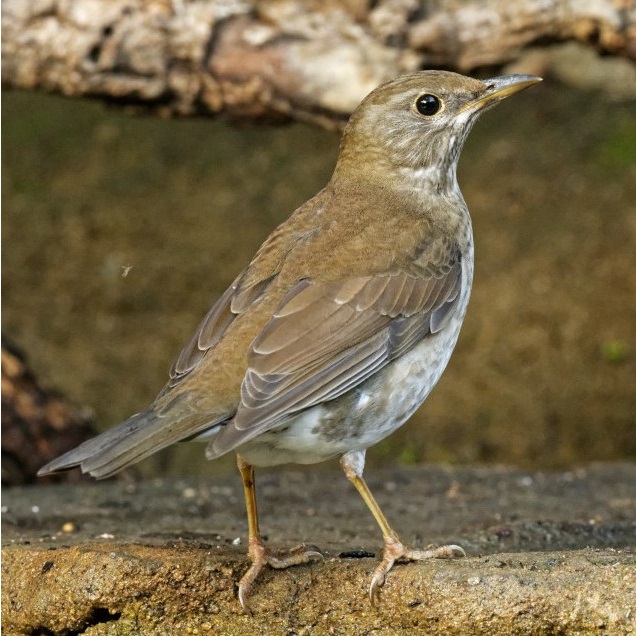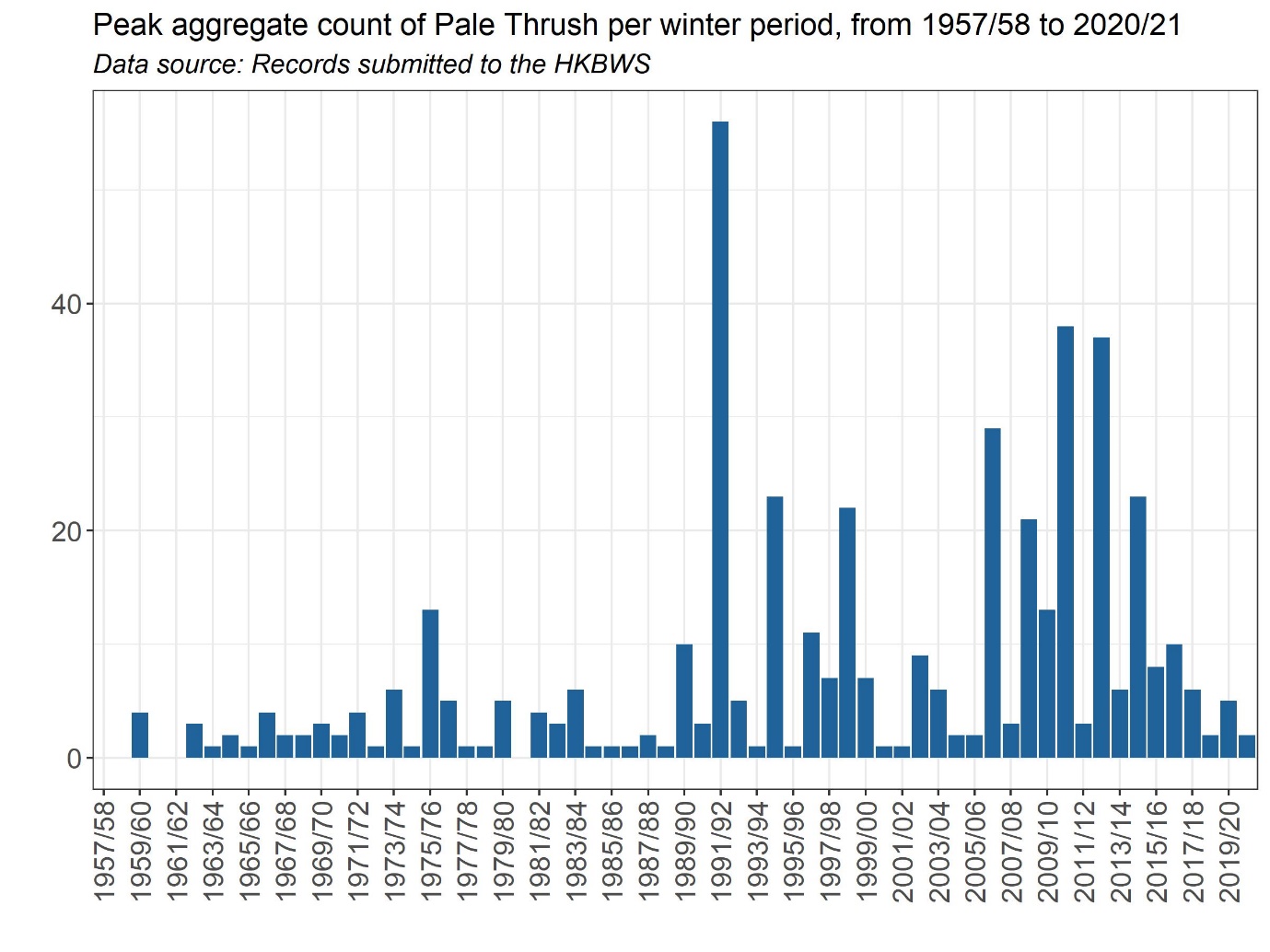Pale Thrush Turdus pallidus 白腹鶇
Category I. Winter visitor to wooded areas, scarce in most years, uncommon in others. Appears to have declined since the 1990s and early 2000s.
IDENTIFICATION

Dec. 2017, Matthew Kwan. Adult male.
22-23 cm. The dullest of the wintering thrushes in HK. Adult male has brownish-grey head, including throat, with small white patch at base of largely yellow bill; upperparts, greater coverts and tertials are dull tawny-brown, which contrast with greyer flight feathers and outer primary coverts; underparts dull greyish, subtly mottled. Whitish corners to the tail are visible in flight.

Jan. 2014, Michelle and Peter Wong. First-winter male.
First-winter males have greyish head flecked pale, streaked sides to the throat and pale underparts and tips to the greater coverts.

Jan. 2020, Guy Miller. First-winter female.
First-year females are very plain. The face is olive-grey with pale flecking, the throat is streaked at the sides and the greater coverts have pale tips in fresh plumage. In flight white corners to the tail are subdued.
Adult females have grey-brown crown with greyer face and whitish throat (with one or two dark malar lines), medium tawny-brown upperparts, greyer flight feathers, dull pale brownish flanks and off-white belly.
VOCALISATIONS
The call uttered either in flight or when perched falls sharply in pitch, is slightly shorter in duration and terminates abruptly in comparison to the commonly-occurring Grey-backed and Japanese Thrush. It is most similar to the call of Brown-headed Thrush.
The alarm call is slightly softer than that uttered by the other Turdus thrushes in HK.
DISTRIBUTION & HABITAT PREFERENCE
Pale Thrushes occur in forest and lightly-wooded areas throughout HK. It tends to occur in ones or twos, with rarely more than five recorded at any one site. The percentage of occupied 1km squares declined from 2.7% to 1.9% between the winter atlas surveys of 2001-05 and 2016-19. Declines occurred in the western and northeast New Territories, and on HK and Lantau Islands.
OCCURRENCE
Most records of Pale Thrush occur from the third week of November to the first week of April (Figure 1), with extreme dates of 4 November 1992 and 2012, and 26 April 1996. The peak period of occurrence is from the first week of January to mid-February indicating cold weather influxes probably occur. Most counts of ten or more birds since 1999 have occurred from 21 November to 6 February, and most of these have been on Po Toi. The highest such count since 1999 is 21 on Po Toi on 18 December 2014. However, the highest on record is an exceptional count of 51 at KFBG on 21 January 1992 after a surge of the northeast monsoon.
Figure 2 illustrates peak weekly aggregate count in each winter period since 1958-59. While the numbers recorded each winter period are variable, and in some years very low indeed, it is notable that since winter 2013/14 there has not been a significant influx.
While Swinhoe (1861) noted Pale Thrush in February and March, it was not recorded again until March 1937 (Herklots 1937). Herklots (1953) mentioned two other records in February and March, while Herklots (1967) stated it was an occasional and rather irregular visitor from mid-January to mid-April.
BEHAVIOUR, FORAGING & DIET
Forages both in fruiting trees and in the leaf litter on the ground, though appears to favour the latter more than some other Turdus thrushes. Has been recorded feeding on the fruit of Ilex rotunda, Melia azedarach and Mallotus paniculatus.
Some birds are site-faithful during the winter: in 1976 singles remained in gardens at Tai Po from 1 January to 16 April and Fanling from 17 January until 20 April, while up to two were regularly seen at Hong Kong University from 1 January to 20 April.
RANGE & SYSTEMATICS
Monotypic. Breeds in Primorye, northeast China and the Korean peninsula; winters in South Korea, Japan south of Hokkaido and south China, including Hainan and Taiwan (Collar and de Juana 2020). In China breeds in the northeast and winters from the Yangtze floodplain south (Liu and Chen 2020).
CONSERVATION STATUS
IUCN: Least Concern. Population trend unknown.
Figure 1.

Figure 2.

Collar, N. and E. de Juana (2020). Pale Thrush (Turdus pallidus), version 1.0. In Birds of the World (J. del Hoyo, A. Elliott, J. Sargatal, D. A. Christie, and E. de Juana, Editors). Cornell Lab of Ornithology, Ithaca, NY, USA. https://doi.org/10.2173/bow.palthr1.01
Herklots, G. A. C. (1937). Notes and Comments. Ornithology. Hong Kong Naturalist 8: 54-59.
Herklots, G. A. C. (1953). Hong Kong Birds. South China Morning Post, Hong Kong.
Herklots, G. A. C. (1967). Hong Kong Birds (2nd ed.). South China Morning Post, Hong Kong.
Liu, Y. and Y. H. Chen (eds) (2020). The CNG Field Guide to the Birds of China (in Chinese). Hunan Science and Technology Publication House, Changsha.
Swinhoe, R. (1861). Notes on the ornithology of Hong Kong, Macao and Canton, made during the latter end of February, March, April and the beginning of May 1860. Ibis 1861: 23-57.

